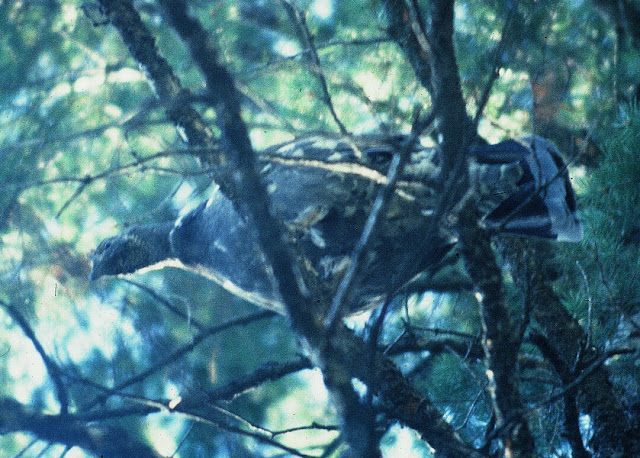I called Bill Brockner the night before for a lead on a Blue Grouse spot. He volunteered to take us to his favorite spot. We met him in the town of Evergreen and followed him to Mount Falcon County Park. We had hiked around in their favored habitat for at least an hour when we decided to head back towards the parking lot. On the way out, I happened to look uphill and see a head and neck stretched out from behind a tree. I quickly called everyone over. It then flew about 15-20 feet up into the tree above us. As we studied it at leisure, the gray terminal band revealed it be one of the "Southern Rockies" form of
Blue Grouse. It was a 'lifer' for Mark and Babe.
A Blue Grouse at Mount Falcon County Park near Morrison, Colorado.
Other birds found in the park included Red-breasted and White-breasted Nuthatch, Dusky Flycatcher, Steller's Jay, Mountain Chickadee, Western and Mountain Bluebird, Townsend's Solitaire, Hermit Thrush, Virginia's Warbler, Western Tanager, Green-tailed and Rufous-sided Towhee, Vesper Sparrow, and the "Black-backed" form of Lesser Goldfinch. As it turned out, Bill used to live in Buffalo and visit Hawk Mountain where knew Rosalie Edge, the Brouns, and Joe Taylor personally. We thanked him for his help and headed for the airport.
During the last three days of our stay, temperatures in the Denver area were around 100 degrees but were accompanied by only 10 to 20 percent humidity. Wildfires were becoming an increasing problem. Everything considered, we had a very successful trip. We turned in the rental car with 2477 extra miles on it and flew back to Allentown by way of Pittsburgh.
I ended the trip with 19 life birds out of the 154 species. Mammals seen included Coyote, Yellow-bellied Marmot, Prairie Dog, Ground Squirrel, Chipmunk, Jackrabbit, Snowshoe Hare, Cottontail, American Elk, Mule Deer, and Pronghorn. A few Texas Horned Toad Lizards were also seen.
Colorado Trip List
1) Western Grebe
2) Clark's Grebe
3) Eared Grebe
4) Pied-billed Grebe
5) American White Pelican
6) Double-crested Cormorant
7) Black-crowned Night-Heron
8) Great Blue Heron
9) White-faced Ibis
10)
Trumpeter Swan*
11) Canada Goose
12) Mallard
13) Gadwall
14) Green-winged Teal
15) American Wigeon
16) Northern Shoveler
17) Blue-winged Teal
18) Cinnamon Teal
19) Ruddy Duck
20) Redhead
21) Lesser Scaup
22) Common Merganser
23) American Coot
24) American Avocet
25) Black-necked Stilt
26)
Snowy Plover*
27) Killdeer
28)
Mountain Plover*
29) Long-billed Curlew
30) Willet
31) Lesser Yellowlegs
32) Spotted Sandpiper
33) Wilson's Phalarope
34) Common Snipe
35)
Franklin's Gull*
36) Ring-billed Gull
37) California Gull
38) Forster's Tern
39) Black Tern
40) Turkey Vulture
41) Golden Eagle
42) Mississippi Kite
43) Northern Harrier
44) Cooper's Hawk
45) Red-tailed Hawk
46) Swainson's Hawk
47)
Ferruginous Hawk*
48) American Kestrel
49) Prairie Falcon
50) Blue Grouse ("Southern Rockies" form)
51) White-tailed Ptarmigan
52)
Sage Grouse*
53) Northern Bobwhite
54) Scaled Quail
55) Ring-necked Pheasant
56) Rock Dove
57) Mourning Dove
58) Great Horned Owl
59) Flammulated Owl (heard only)
60) Burrowing Owl
61) Common Nighthawk
62) Chimney Swift
63) White-throated Swift
64) Broad-tailed Hummingbird
65) Belted Kingfisher
66) Northern "Red-shafted" Flicker
67) Lewis's Woodpecker
68) Williamson's Sapsucker
69)
Red-naped Sapsucker*
70) Hairy Woodpecker
71)
Three-toed Woodpecker*
72) Eastern Kingbird
73) Western Kingbird
74) Scissor-tailed Flycatcher
75) Western Wood-Pewee
76) Say's Phoebe
77)
Gray Flycatcher*
78)
Dusky Flycatcher*
79)
Hammond's Flycatcher*
80)
Cordilleran (Western) Flycatcher*
81) Horned Lark
82) Tree Swallow
83) Violet-green Swallow
84) Cliff Swallow
85) Barn Swallow
86) Scrub Jay
87) Steller's Jay
88) Gray Jay
89) Clark's Nutcracker
90) Black-billed Magpie
91) American Crow
92) Common Raven
93) Plain Titmouse
94) Black-capped Chickadee
95) Mountain Chickadee
96) White-breasted Nuthatch
97) Red-breasted Nuthatch
98) Pygmy Nuthatch
99) House Wren
100) Canyon Wren
101) Ruby-crowned Kinglet
102) Western Bluebird
103) Mountain Bluebird
104) Townsend's Solitaire
105) Hermit Thrush
106) American Robin
107) Loggerhead Shrike
108) Gray Catbird
109) Northern Mockingbird
110)
Sage Thrasher*
111) Brown Thrasher
112) American (Water) Pipit
113) American Dipper
114) European Starling
115) Solitary Vireo
116) Warbling Vireo
117) Virginia's Warbler
118) Yellow-rumped "Audubon's" Warbler
119) Yellow Warbler
120) MacGillivray's Warbler
121) Black-headed Grosbeak
122) Indigo Bunting
123)
Lazuli Bunting*
124) Green-tailed Towhee
125) Rufous-sided Towhee
126) Vesper Sparrow
127) Savannah Sparrow
128) Song Sparrow
129) Lark Sparrow
130)
Cassin's Sparrow*
131) Chipping Sparrow
132) Brewer's Sparrow
133) Dark-eyed "Gray-headed" Junco
134) White-crowned Sparrow
135) Lincoln's Sparrow
136)
Chestnut-collared Longspur*
137)
McCown's Longspur*
138)
Lark Bunting*
139) Western Meadowlark
140) Yellow-headed Blackbird
141) Red-winged Blackbird
142) Brewer's Blackbird
143) Brown-headed Cowbird
144) Common Grackle
145) Northern "Bullock's" Oriole
146) Western Tanager
147) House Sparrow
148) Pine Siskin
149) American Goldfinch
150) Lesser "Black-backed" Goldfinch
151) Pine Grosbeak
152) "Brown-capped" Rosy-Finch
153)
Cassin's Finch*
154) House Finch




































